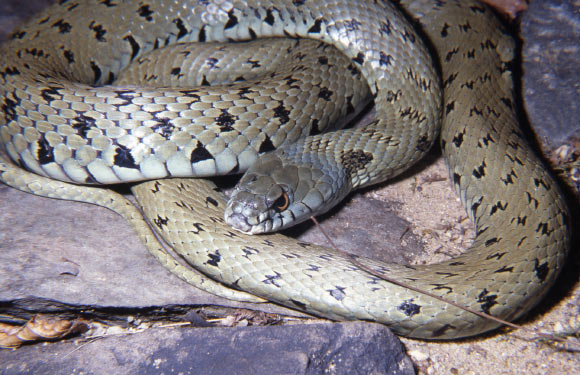An international team of scientists from Czech Republic, France and Germany has identified a cryptic new species of grass snake living in the North African Maghreb region, the Iberian Peninsula and neighboring France.
Grass snakes are non-venomous creatures that live in ponds, swamps and rivers.
The common grass snake (Natrix natrix) is Europe’s most widely distributed and, in many regions, most common snake species, with many morphologically defined subspecies.
“It may well be due to this abundance that there are so many different views regarding their taxonomy. Depending on the author, the number of recognized subspecies ranges from 4 to 14,” said Prof. Uwe Fritz of the Senckenberg Natural History Collections in Dresden.
Prof. Fritz and his colleagues found strong evidence that a subspecies of the grass snake called Natrix natrix astreptophora is in fact a distinct species.
“Europe’s vertebrates are generally well-studied – the discovery of an additional species is therefore quite remarkable,” said Carolin Kindler, also from the Senckenberg Natural History Collections.
The researchers used various methods to study more than 300 snakes from different museum collections and combined this data set with genetic data of 85 grass snakes.
“We connected external morphology, such as scale numbers, with characteristics of the skeleton and genetic features, and based on these results, we found out that the Iberian grass snake – Natrix astreptophora – constitutes a full species,” said Prof. Fritz, senior author of a paper published online in the Biological Journal of the Linnean Society.
The genetic analysis also shows that Natrix astreptophora does not share its habitat with Natrix natrix, whose subspecies are widely distributed throughout Europe and Asia.
“The two species only meet in the south of France, near the Pyrenees. But there is virtually no hybridization between the two species in this region – strong evidence that Natrix astreptophora constitutes a separate species,” Prof. Fritz explained.
“As a hunter of amphibians and other small animals, the grass snake, which can reach a length up to 150 cm, is tied to wet habitats – and these are increasingly threatened by the draining of wetlands, the regulation of river courses and the intensification of fish farming.”
“The Iberian grass snake, however, is much less dependent on the presence of water than its wide-spread relative. Many grass snakes fall victim to automobile traffic; around some of the larger lakes, tourism poses yet another threat to the grass snakes.”
“The knowledge about which species we are dealing with helps us to better assess the threat level and to implement timely protection measures,” Kindler said.
“This is of particular importance, since the Iberian grass snake prefers different types of habitat.”
_____
Felix Pokrant et al. Integrative taxonomy provides evidence for the species status of the Ibero-Maghrebian grass snake Natrix astreptophora. Biological Journal of the Linnean Society, published online February 22, 2016; doi: 10.1111/bij.12782








